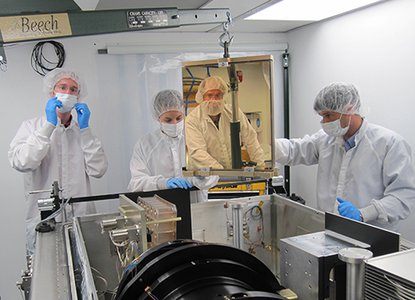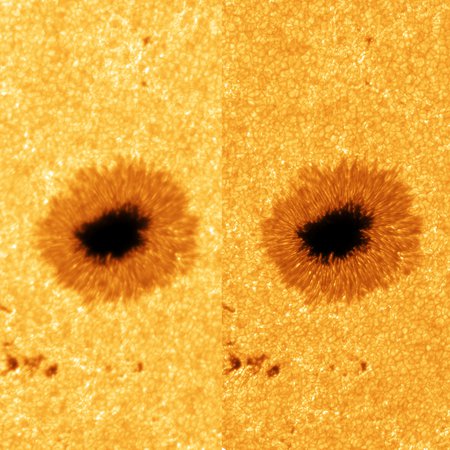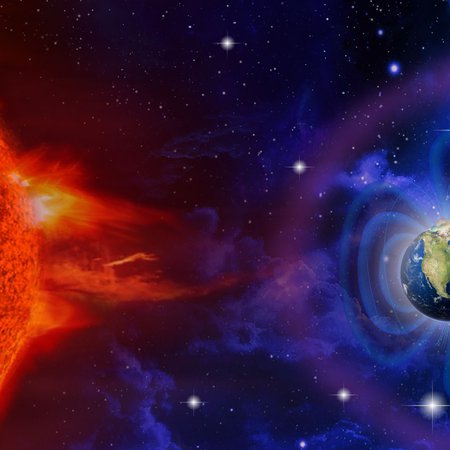This is your galaxy – New data help astronomers explore the hidden Milky Way
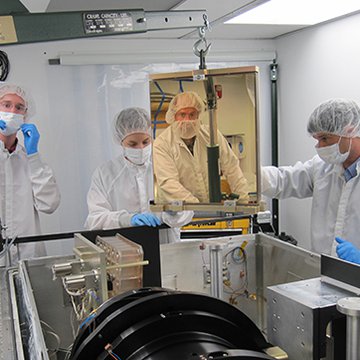
Four SDSS-III scientists working on the APOGEE spectrograph.
Credit: Dan Long, Apache Point ObservatoryToday, astronomers with the Sloan Digital Sky Survey III (SDSS-III) released a new online public data set featuring 60,000 stars that are helping to tell the story of how our Milky Way galaxy formed.
The highlight of today's "Data Release 10" is a new set of high-resolution stellar spectra using infrared light, invisible to human eyes but able to penetrate the veil of dust that obscures the center of the Galaxy.
The new spectra are the first data released by the SDSS-III's Apache Point Observatory Galactic Evolution Experiment (APOGEE), an effort to create a comprehensive census of our Milky Way galaxy. The question of how our Milky Way galaxy formed has been the subject of scientific speculation and debate for hundreds of years. APOGEE's three-dimensional map will provide key information for resolving central questions about how our galaxy formed over the many billions of years of its history.
Cristina Chiappini, scientist at the Leibniz Institute for Astrophysics Potsdam (AIP) and contributor to SDSS-III: “These new data give us the opportunity to set up more constrained and accurate models of the formation of our galaxy than ever before. With the chemical and kinematic details SDSS/APOGEE provide for our Galaxy we get to a deeper understanding of the processes that underlie galaxy formation in general.”
About the Sloan Digital Sky Survey
Funding for SDSS-III has been provided by the Alfred P. Sloan Foundation, the Participating Institutions, the National Science Foundation, and the U.S. Department of Energy Office of Science. SDSS-III is managed by the Astrophysical Research Consortium for the Participating Institutions of the SDSS-III Collaboration including the University of Arizona, the Brazilian Participation Group, Brookhaven National Laboratory, Carnegie Mellon University, University of Florida, the French Participation Group, the German Participation Group, Harvard University, the Instituto de Astrofisica de Canarias, the Michigan State/Notre Dame/JINA Participation Group, Johns Hopkins University, Lawrence Berkeley National Laboratory, Max Planck Institute for Astrophysics, Max Planck Institute for Extraterrestrial Physics, New Mexico State University, New York University, Ohio State University, Pennsylvania State University, University of Portsmouth, Princeton University, the Spanish Participation Group, University of Tokyo, University of Utah, Vanderbilt University, University of Virginia, University of Washington, and Yale University.
Further information
Press release by the SDSS collaboration, including high-resolution images
http://www.sdss3.org/press/dr10.php
Data publication
SDSS-III website
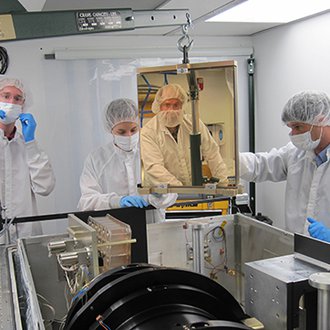
Four SDSS-III scientists working on the APOGEE spectrograph.
Credit: Dan Long, Apache Point ObservatoryToday, astronomers with the Sloan Digital Sky Survey III (SDSS-III) released a new online public data set featuring 60,000 stars that are helping to tell the story of how our Milky Way galaxy formed.
The highlight of today's "Data Release 10" is a new set of high-resolution stellar spectra using infrared light, invisible to human eyes but able to penetrate the veil of dust that obscures the center of the Galaxy.
The new spectra are the first data released by the SDSS-III's Apache Point Observatory Galactic Evolution Experiment (APOGEE), an effort to create a comprehensive census of our Milky Way galaxy. The question of how our Milky Way galaxy formed has been the subject of scientific speculation and debate for hundreds of years. APOGEE's three-dimensional map will provide key information for resolving central questions about how our galaxy formed over the many billions of years of its history.
Cristina Chiappini, scientist at the Leibniz Institute for Astrophysics Potsdam (AIP) and contributor to SDSS-III: “These new data give us the opportunity to set up more constrained and accurate models of the formation of our galaxy than ever before. With the chemical and kinematic details SDSS/APOGEE provide for our Galaxy we get to a deeper understanding of the processes that underlie galaxy formation in general.”
About the Sloan Digital Sky Survey
Funding for SDSS-III has been provided by the Alfred P. Sloan Foundation, the Participating Institutions, the National Science Foundation, and the U.S. Department of Energy Office of Science. SDSS-III is managed by the Astrophysical Research Consortium for the Participating Institutions of the SDSS-III Collaboration including the University of Arizona, the Brazilian Participation Group, Brookhaven National Laboratory, Carnegie Mellon University, University of Florida, the French Participation Group, the German Participation Group, Harvard University, the Instituto de Astrofisica de Canarias, the Michigan State/Notre Dame/JINA Participation Group, Johns Hopkins University, Lawrence Berkeley National Laboratory, Max Planck Institute for Astrophysics, Max Planck Institute for Extraterrestrial Physics, New Mexico State University, New York University, Ohio State University, Pennsylvania State University, University of Portsmouth, Princeton University, the Spanish Participation Group, University of Tokyo, University of Utah, Vanderbilt University, University of Virginia, University of Washington, and Yale University.
Further information
Press release by the SDSS collaboration, including high-resolution images
http://www.sdss3.org/press/dr10.php
Data publication
SDSS-III website
Images
Four SDSS-III scientists working on the APOGEE spectrograph.
